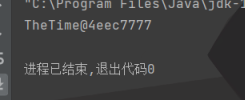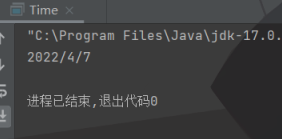目录
Object类中的方法
Object 类位于 java.lang 包中,编译时会自动导入,我们创建一个类时,如果没有明确继承一个父类,那么它就会自动继承 Object,成为 Object 的子类
隐式继承:
public class 类名{}显示继承
public class 类名 extends Object{}
| 方法名 | 格式 | 作用 |
| clone | object.clone() | 创建并返回一个对象的拷贝 |
| equals | object.equals(Object obj) | 比较两个对象是否相等 |
| finalize | protected void finalize() | 当 GC (垃圾回收器)确定不存在对该对象的有更多引用时,由对象的垃圾回收器调用此方法。 |
| getClass | object.getClass() | 获取对象的运行时对象的类 |
| hashCode | object.hashCode() | 获取对象的 hash 值 |
| notify | public final void notify() | 唤醒在该对象上等待的某个线程 |
| notifyAll | public final void notifyAll() | 唤醒在该对象上等待的所有线程 |
| toString | object.toString() | 返回对象的字符串表示形式 |
| wait | public final void wait() | 让当前线程进入等待状态。直到其他线程调用此对象的 notify() 方法或 notifyAll() 方法 |
toString方法
public String toString ()返回对象的字符串表示形式,以文本方式表示这个对象(建议子类重写)
未重写时的结果,得到的是一个默认实现,即对象的内存地址,如下图:
public class Time { public static void main(String[] args) { //创建对象并传入参数值 TheTime t = new TheTime(2022, 4, 7); //创建一个String 对象 t1 用于接收对象 t 调用toString方法后得到的值 String t1 = t.toString(); System.out.println(t1); } } class TheTime{ int year; int month; int day; //构造方法 public TheTime(){ } public TheTime(int year , int month , int day ){ this.year = year ; this.month = month ; this.day = day ; } }
重写后:
public class Time { public static void main(String[] args) { //创建对象并传入参数值 TheTime t = new TheTime(2022, 4, 7); //创建一个String 对象 t1 用于接收对象 t 调用toString方法后得到的值 String t1 = t.toString(); System.out.println(t1); } } class TheTime{ int year; int month; int day; //构造方法 public TheTime(){ } public TheTime(int year , int month , int day ){ this.year = year ; this.month = month ; this.day = day ; } //重写toString方法 public String toString(){ return this.year + "/"+ this.month + "/" + this.day; } }
equals方法
默认实现:
public boolean equals (Object obj){ return (this == obj); }注意:
==(双等号) 判断两个基本数据类型的值是否相等 equals() 判断两个java对象是否相等 重写前(t1和t2传入的参数值一样但输出是false):
原因:重写前,在equals方法中使用的==双等号
public class Time { public static void main(String[] args) { //创建对象并传入参数值 TheTime t1 = new TheTime(2022, 4, 7); TheTime t2 = new TheTime(2022, 4, 7); t1.equals(t2); boolean T = t1.equals(t2); System.out.println(T); } } class TheTime{ int year; int month; int day; //构造方法 public TheTime(){ } public TheTime(int year , int month , int day ){ this.year = year ; this.month = month ; this.day = day ; } }

重写后:
public class Time { public static void main(String[] args) { //创建对象并传入参数值 TheTime t1 = new TheTime(2022, 4, 7); TheTime t2 = new TheTime(2022, 4, 7); t1.equals(t2); boolean T = t1.equals(t2); System.out.println(T); } } class TheTime{ int year; int month; int day; //构造方法 public TheTime(){ } public TheTime(int year , int month , int day ){ this.year = year ; this.month = month ; this.day = day ; } //重写equals方法 public boolean equals (Object obj){ //获取t1 int year = this.year; int month = this.month; int day = this.day; //向下转型 if(obj instanceof TheTime){ TheTime t = (TheTime)obj; int year1 = t.year; int month1 = t.month; int day1 = t.day; if(year == year1 && month == month1 && day == day1){ return true; } } return false; } }
finalize方法
Object finalize() 方法用于实例被垃圾回收器回收的时触发的操作。
当 GC (垃圾回收器) 确定不存在对该对象的有更多引用时,对象的垃圾回收器就会调用这个方法
(1)finalize只有一个方法体,用protected修饰(JDK高版本此方法是过时的)
(2)不需要手动调用,JVM垃圾回收器负责调用
(3)如果垃圾数量太少,太小可能不会执行
(4)可以使用 System.gc() 建议启动垃圾回收器
数量太小时,不会执行:
public class 垃圾回收 { public static void main(String[] args) { Rubbish R = new Rubbish(); } } class Rubbish{ protected void finalize(){ System.out.println("正在回收"); } }数量达到时:
public class 垃圾回收 { public static void main(String[] args) { for (int i = 0; i <= 1000; i++) { Rubbish R = new Rubbish(); R.finalize(); } } } class Rubbish{ protected void finalize(){ System.out.println("正在回收"); } }
HashCode方法
hashCode()方法的返回是哈希码,即一个java对象的内存地址,经过哈希算法,得出的一个值,可以看作一个java对象的内存地址
public class 哈希 { public static void main(String[] args) { Object obj1 = new Object(); System.out.println(obj1.hashCode()); Object obj2 = new Object(); System.out.println(obj2.hashCode()); Object obj3 = new Object(); System.out.println(obj3.hashCode()); } }




























 3936
3936











 被折叠的 条评论
为什么被折叠?
被折叠的 条评论
为什么被折叠?










